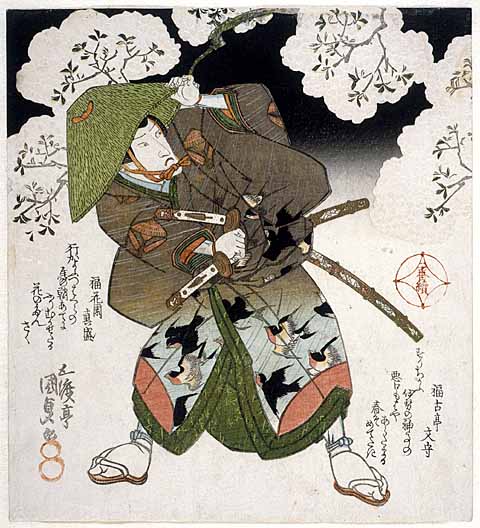

Ichikawa Danjuro VII as Fuwa Banzaemon (right) and Onoe Kikugoro III as Nagoya Sanza in Sato no haru meibutsu amigasa (Famous sedge hats during spring in Yoshiwara) performed at the Kawarazaki theatre in 01/1827
Kunisada 78
Given to the Fitzwilliam Museum by E. Evelyn Barron in 1937
A surimono diptych showing the famous Scabbards clashing (Saya-ate) scene in a revival (with a different name) of the play that first brought Danjuro VII and Kikugoro III together in these highly successful roles in 1823.
This scene was subsequently performed as a separate dance-drama. Fuwa Banzaemon carries a sword named Thunder and wears a kimono decorated with a pattern of lightning-in-the-clouds. His rival Nagoya Sanza carries a sword named Amorous Swallows and wears a kimono with a swallows-in-the-rain pattern tied with a sash of knitted rope. Unaware of each other, they make simultaneous entrances boasting of their fame, along the two raised passageways (hanamichi) that run through the audience to the main stage.
As they pass on the main stage, which represents Nakano Street in the Yoshiwara pleasure district at cherry blossom time, their sword hilts clash a breach of etiquette demanding an apology. This depiction shows them at the moment when they raise their deep sedge traveling-hats and recognize each other, before drawing swords to fight over the courtesan Katsuragi, whom they both love.
It seems that Danjuro VII was only recruited for this performance after a fire prevented him from appearing as Kagekiyo at the Ichimura theatre.
Collections Record: P.475-1937 & P.474-1937

Ichikawa Ebizo V (formerly Danjuro VII) as Fuwa Banzaemon seen in a mirror c. 1849
Given to the Fitzwilliam Museum by E. Evelyn Barron in 1937
Fragment of a much larger surimono made for the Go poetry group, with a text of poems praising the actor, and the image of a peony (one of the Ichikawa family symbols) designed by Totoya Hokkei (1780-1850). The complete print bears Kunisada’s seal reading Kunisada aratame ni-sei Toyokuni no in (Seal of Kunisada changing to Toyokuni II), which records his adoption of his master Toyokuni;s name in New Year 1844.
The print was probably designed in 1849, when his son Danjuro VIII went to visit his father Ichikawa Ebizo V (formerly Danjuro VII) in exile in Osaka. Danjuro VII had been banished from Edo by the government (bakufu) in 1842 in punishment for his luxurious lifestyle as part of the Tempo reforms. The print shows Danjuro VII in one of his most famous roles, which was depicted many times in prints with the characteristic lightning-in-the-clouds pattern on Fuwa Banzaemon’s costume. The device of portraying an actor reflected in a mirror was used by Kunisada many times.
Collections Record: P.516-1937
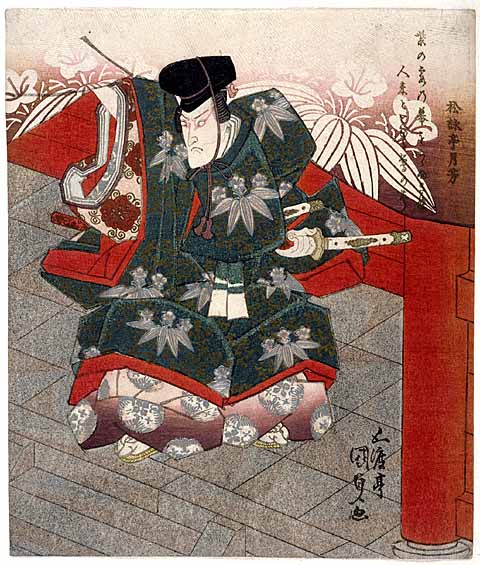
Bando Mitsugoro III as Shigetada (right) and Ichikawa Danjuro VII as Kagekiyo (left) in Kagekiyo c. 1826/7
Kunisada 77
Given to the Fitzwilliam Museum by E. Evelyn Barron in 1937
An interesting case where a surimono was produced for a play that was advertised but never performed. Kagekiyo was announced to open at the Ichimura theatre on the 9th day of the first month of 1827 with Danjuro VII as Taira no Kagekiyo, and Mitsugoro III as Hatakeyama Shigetada. However, the theatre burned down a few days before the opening and Danjuro VII was immediately recruited to perform at the Kawarazaki theatre in Sato no haru meibutsu amigasa (Famous sedge hats during spring in Yoshiwara).
Kagekiyo was the subject of several of the Eighteen Plays (Kabuki Juhachiban) selected by Danjuro VII as specially associated with the Ichikawa lineage of actors. Head samurai of the Taira clan, he was often presented as a master of the narrow escape, particularly in his failed attempts to assassinate Minamoto Yoritomo, head of the Genji clan. In this scene he disguises himself as a monk-soldier of the Todaiji temple in Nara, and waits for a chance to attack Yoritomo who is behind the curtain in the Great Buddha Hall officiating at the dedication of the newly restored temple in 1195. At this moment Yoritomo’s vassal, Shigetada, sees through the disguise. The design on the curtain and on Shigetada’s robe is the symbol of the Genji; the design on his pantaloons is Mitsugoro’s symbol.
The printing of this surimono employs a variety of exquisite effects, including the embossing of the texture of the billowing curtain, the metallic pigments on the armour, and the flecked pattern on the stone pavement which was sprayed through a bamboo straw. On some other impressions the seal of the printer Shunfudo Ryucho appears.
Collections Record: P.477-1937

Ichikawa Danjuro VII as Jo and Segawa Kikunojo V as Uba c. 1823-5
Given to the Fitzwilliam Museum by E. Evelyn Barron in 1937
A surimono showing a scene from a play based on the subject of the Eternal Couple from the Legend of Takasago. Jo and Uba were supposed to have fallen in love when young, and after living to a very old age their spirits came to abide in pine trees, one on the beach at Takasago in Harima, and the other at Sumiyoshi in Sesshu near Osaka. Their spirits returned on moonlit nights in human form with rakes to continue their work of clearing the pine needles on Takasago Beach. The legend inspired the No play Takasago, and was subsequently taken up by Kabuki, especially in the celebratory Takasago mono (Takasago dances), a line of celebratory dances, such as Takasago tanzen, premiered in 1785. In this print the actors are holding No masks.
The Eternal Couple were a popular subject in art. They are usually shown, Jo with a rake and Uba with a broom, sweeping pine needles, which symbolise longevity, an appropriate wish for surimono intended as New Year gifts.
The producer’s seal of Suriko Kozen appears on the print.
Collections Record: P.480-1937
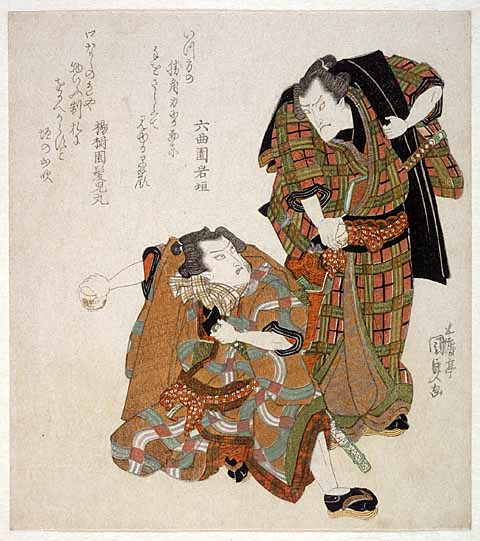
Ichikawa Ebijuro I as Nuregami Chogoro and Ichikawa Danjuro VII as Hanaregoma Chokichi in Futatsu chocho kuruwa nikki (Two butterflies of the licensed quarter) performed at the Kawarazaki theatre in
05/1820
Given to the Fitzwilliam Museum by E. Evelyn Barron in 1937
In this surimono both actors wear the traditional wrestlers dress of a folded haori jacket across the shoulders, and a second sash (uwajime) over the first to stop it unravelling. The play derived from the puppet theatre and appears to have been based on a true event in which a quarrelsome Sumo wrestler named Nuregami Chogoro killed a samurai and was captured after hiding out at his fathers house in Yawata village.
In the play, Hanaregoma Chokichi is an amateur wrestler whose patron is at odds with Chogoros patron Yogoro. In this scene the two wrestlers engage in a test of strength to see who can crush a tea cup with their bare hand. Chogoro succeeds, but the amateur Chokichi has to cheat by hitting the cup against the guard of his sword (katana no scuba). The two later swear allegiance as blood brothers. The words futatsu (two) and chocho (butterflies) in the plays title pun on the wrestlers names, which both include the character cho (long).
Collections Record: P.488-1937

Ichikawa Danjuro VII as a medicine seller in front of a cartouche of Danjuro IV as Kagekiyo
Given to the Fitzwilliam Museum by E. Evelyn Barron in 1937
This surimono is sealed beneath Kunisada’s signature with the artist’s sada seal in the form of the mimasu (triple-rice-measure) box which was the Ichikawa lineage acting crest (mon). It also bears the production seal of Kubo Shumman (1757-1820), indicating that Kunisada’s design was cut and printed by the Shumman studio. It was commissioned by the Go poetry group, whose stylised symbol made up of the character for ‘five’ (go) is used as the pattern on the upper part of Danjuro IV’s outer robe.
The surimono may have been intended as a memorial to Danjuro IV, and celebrates roles which were specialities of the Ichikawa lineage of actors. Kagekiyo was revived and revised by Danjuro IV and included by Danjuro VII in his selection of Eighteen Plays (Kabuki Juhachiban) specially associated with the Ichikawa lineage. The Ichikawa mimasu crest (mon) is seen on the hilt of Danjuro IV’s sword. He holds in a bag the precious biwa (lute) called Seizan, which Kagekiyo is hiding from his Genji enemies.
Danjuro VII is shown in the foreground holding a fan in one hand, which is embossed with the silver triple stripe (misuji) associated with the Ichikawa lineage. In the other hand he holds a medicine packet bearing the character uira[u], referring to the medicine uiro, which was supposed to cure everything from constipation to bad breath. The larger black case on his back has the characters for [O]dawara, the place where the medicine was produced. Uiro sellers were famous for their high-pitched voices and rapid sales-talk. Danjuro II, celebrated for his elocution, incorporated a uiro seller into a play on a Soga theme in 1718 (Wakamidori ikioi Soga), in which he is actually Soga no Juro in disguise. Danjuro VII wears the costume associated with this role: decorated with lucky coins and with a lining motif of sacred shimenawa ropes and dangling paper streamers. He later incorporated the role into a performance of Sukeroku yukari no Edo zakura (Sukeroku’s affinity for the cherry blossoms of Edo), in which he passed the Danjuro name onto his ten-year-old son, who became Danjuro VIII.
The poem on the surimono by Dokurakudo Takamori weaves into a standard New Year kyoka an allusion to the famed verbal gymnastics of the uiro seller, which in the play were supposedly due to the piece of uiro that he had put into his mouth:
Saku ume no With the scent of plum kaori fukumeba blossoms filling its mouth, ima masa ni the warbler in the courtyard shita yoku mawaru is now readied to recite yado no uguisu its elegant tongue-twisters.
(translation by John Carpenter)
Collections Record: P.493-1937
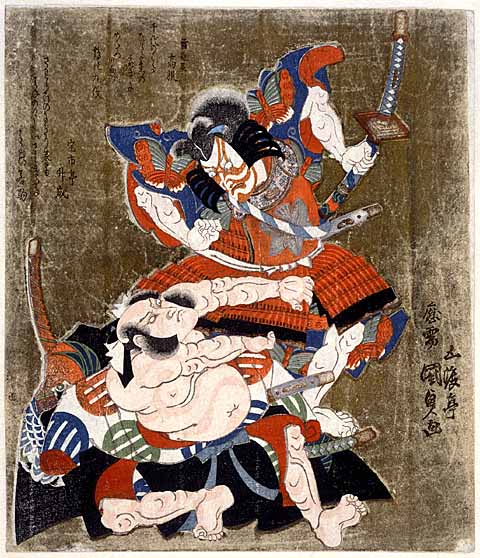
Ichikawa Danjuro VII as Soga no Goro and Bando Mitsugoro III as Asaina no Saburo in the armour-pulling scene (kusazuribiku)
Kunisada 81
1827 Given to the Fitzwilliam Museum by E. Evelyn Barron in 1937
A surimono of the famous armour-pulling scene (kusazuribiki) which had become a highpoint of various Kabuki plays telling of the revenge of the two Soga brothers, Soga no Juro and Soga no Goro, on their fathers murderer Kudo Suketsune. Soga no Goro, believing his brother to be in mortal danger, rushes out from hiding to his defence, only to be held back by the legendary strongman warrior Asaina no Saburo (1176-?) tugging at the skirt of his armour. Goro was said to have held his ground like a guardian statue. This print probably depicts an imaginary performance of a Soga brothers vendetta play, as these actors did not appear in these roles in 1827.
Danjuros costume bears the Soga butterfly crest, while his sword-hilt is decorated with the Ichikawa acting crest (mon) of three concentric boxes, or triple-rice-measure (mimasu). Mitsugoros acting crest (mon)a circle containing the triple-stroke character for threedecorates his costume.
The first poem puns on the verb hikeru, which can refer either to trailing mists or tugging. The other poem likens the curling leaves of springtime bracken ferns to clenched fists.
Collections Record: P.503-1937
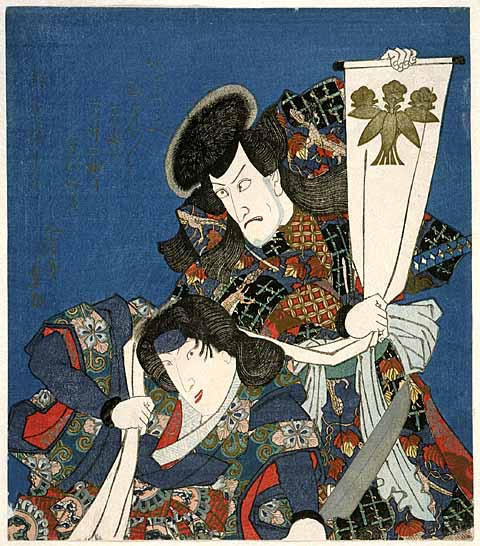
Iwai Shijaku I and Ichikawa Danjuro VII in a Gempei play
c.1827-30
Given to the Fitzwilliam Museum by E. Evelyn Barron in 1937
In this surimono Shijaku’s unidentified character has round her neck the end of the white flag of the Genji (Minamoto) clan held by the warrior played by Danjuro VII. The play, which is yet to be identified, was evidently one of the many based on the Gempei seisuiki (Account of the Gempei wars) and Heike monogatari (Tales of the Heike), involving incidents from the wars between the Heike (Taira) and the Genji (Minamoto) clans in the twelfth century. Iwai Shijaku (1804-45), his father Iwai Hanshiro V (1776-1847), and his brother Iwai Kumesaburo II (1799-1836), were (along with Segawa Kikunojo V) the leading female impersonators (onnagata) of the Bunka (1804-17) and Bunsei (1818-29) eras.
Collections Record: P.505-1937

Ichikawa Danjuro VII as Fuwa Banzaemon
Collections Record: P.514-1937

Ichikawa Danjuro VII as Mongaku (bottom) and Ichikawa Danjuro V as Fudo Myo-o (top) c. 1832
Given to the Fitzwilliam Museum by E. Evelyn Barron in 1937
Spring kyoka surimono showing the scene of Mongaku Shonin (1120-99) reciting prayers under the icy waterfall of Nachi in penance for accidentally killing his lover. He witnesses a manifestation of the Buddhist deity Fudo Myo-o (the guardian of waterfalls) who appears at the top with his two attendants (doji) Kongara and Seitaka. A number of plays were derived from this story, based on the Heike monogatari (Tales of the Heike) and Gempei seisuiki (Account of the Genpei wars), but this is evidently an ‘imaginary grouping’, rather than a record of an actual production, as Kunisada depicts Danjuro VII’s deceased grandfather, Danjuro V, in the role of Fudo.
The scene had a special significance for the Danjuro lineage of actors ever since their founder, Danjuro I (1660-1704), prayed successfully to the image of Fudo at the Shinshoji temple in Narita, and thereafter used Naritaya as his yago (‘house name’), the nickname shouted out by fans to encourage him during performance. Before assuming the Danjuro stage-name, actors performed the same religious purification (misogi) as Mongaku at the waterfall at Shinshoji, where it was believed that the spirit of Fudo came to inhabit them. A votive plaque painted by Kunisada at the temple also records this scene.
The poem by Umenoya plays irreverently by associating Fudo’s coiled rope with the rope used to wrap wine casks as temple or shrine offerings, and by transforming the penitential waterfall (taki) into a famous brand of wine, Takisui (literally, ‘water from a waterfall’), which was sold at the Yomo wine shop in Izumicho in the Kanda district of Edo.
Collections Record: P.507-1937

Ichikawa Danjuro VII as Kan Shojo (top) and Segawa Kikunojo V as Umeomaru (bottom) in Sugawara denju tenarai kagami (Sugawara and the secrets of calligraphy) performed at the Kawarazaki theatre in 09/1832 Kunisada 87
Given to the Fitzwilliam Museum by E. Evelyn Barron in 1937
Spring kyoka surimono commemorating the performance in the ninth month of 1832 at the Kawarazaki Theatre in Edo of Sugawara denju tenarai kagami (Sugawara and the secrets of calligraphy). The print shows the Tempaizan scene at Mount Tempai on Kyushu, where the exiled Sugawara, known as Kan Shojo, learns in a dream that his favourite plum tree from the garden in his home in Sada village has been moved to nearby Anraku Temple so that he may enjoy its blossoms. When he goes there he encounters one of his retainers, Umeomaru, involved in a duel. He breaks off a branch from the tree and magically decapitates Umeomaru’s opponent. He then learns from Umeomaru that his loss of position at court and subsequent exile are due to the machinations of his rival Shihei (Fujiwara Tokihira). Flying into a rage he turns into the Thunder god, raises a storm and, to the accompaniment of lightning, flies off to the capital (Kyoto) to muster support in preventing Shihei from gaining power.
The print conflates the scene of the duel with Kan Shojo’s transformation into the Thunder God. The poems include images of blossoms of plum (umeo), and Umeomaru’s jacket is decorated with the flower. Kan Shojo was one of Danjuro’s most celebrated roles. Almost twenty years earlier Kunisada designed a print of him in the role with the branch of plum blossom clenched between his teeth, in a set of ‘Great Performances’.
Collections Record: P.512-1937
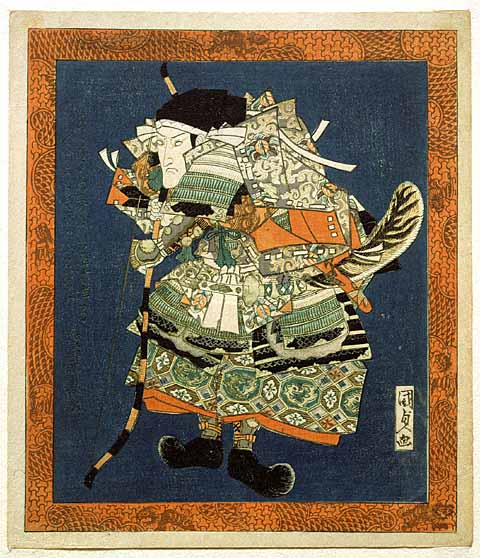
Bando Mitsugoro III as Minamoto no Yorimasa (right), Segawa Kikunojo V (centre) and Ichikawa Danjuro VII as I no Hayata (left)
1820
Given to the Fitzwilliam Museum by E. Evelyn Barron in 1938
A set of three spring kyoka surimono, probably made for the year of the dragon 1820 (a dragon motif appears in the border). The prints form a triptych showing a scene which appeared in plays performed by the Ichikawa lineage of actors, and derived from the warrior chronicles Heike monogatari and Gempei seisuiki. In 1153 the Emperor commanded the poet and warrior Minamoto no Yorimasa (1104-80) to discover the cause of the cries that emanated every night from a black cloud hanging over the palace, which frightened him senseless. Yorimasa took with him the loyal henchman I no Hayata.
When the black cloud appeared from the forest, Yorimasa fired an arrow at it, whereupon a monstrous creature with the head of a monkey, the body of a badger, the tail of a serpent and the legs of a tiger, fell from the cloud uttering the cry of the golden mountain thrush. Hayata rushed forward and stabbed it. The story of the killing of the Nue (as it was called) was adapted as a No play and was incorporated by Danjuro II into the Kabuki play Yorimasa sambaso in 1708, which was subsequently performed in many versions.
The two outer prints conform closely to other representations of the scene (such as an early Meiji period theatre sign painted by Kunisada’s pupil, Kunitoshi, now in the British Museum), but the central female figure (apparently performing a dance) takes the place of the usual depiction of the monstrous Nue. This supports the idea that this is an ‘imaginary grouping’ of the scene rather than a record of an actual production.
This seems confirmed by the fact that these three actors had not appeared together in these roles by 1820, the date suggested by the zodiac references to the year of the dragon that appear in the borders and in one of the poems on the central image, which mentions a ‘dragon spring’. Danjuro’s symbols the mimasu (triple-rice-measure) and peony appear along the edge of his armour.
Collections Record: P.57-1938



